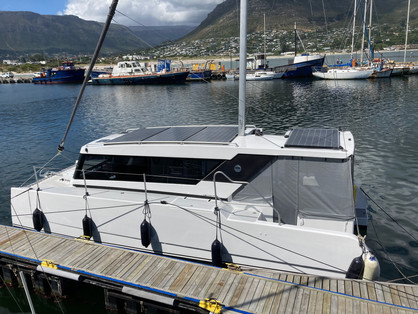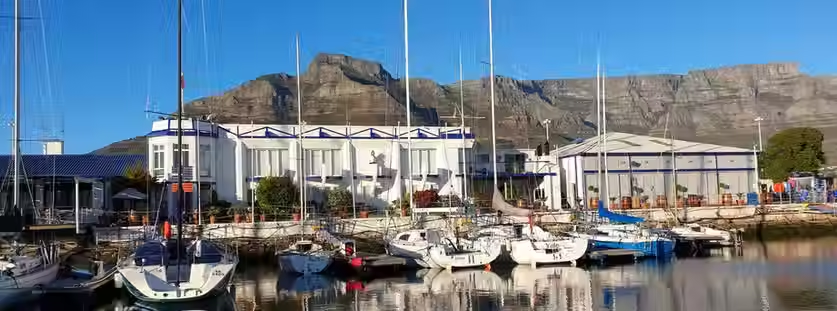The advantages of E-sailing.
- paultomes
- Nov 22, 2022
- 4 min read
Updated: Sep 18

Our first test sail in the new HopYacht 30 was off the coast of Cape Town, South Africa. Whilst we would have preferred to have had a moderate breeze for our first sail, once clear of the wind shadow created by Table Mountain, it became very clear that like it or not, we would be testing the boat in 20-25 knots of wind.
Under full genoa the boat handled so well, that we double checked to see if we hadn't read the wind speed incorrectly. 23 knots of wind on a beam reach and HopYacht sped across the bay at a respectable 7 knots.
On paper, the designers had recommended reefing to the second line marked on the genoa. In reality with full sail, the boat felt completely under control, no weather helm and around 5 degrees of heel. Our first and now lasting impression is that our HopYacht 30 is exceptionally easy to sail and the low aspect rig is very forgiving.
We had a drone pilot onboard and this short video gives you a great feel for how the HopYacht 30 performed.
As designers and builders, we knew that we would be a little biased, looking for the positives and overlooking any negatives. So we invited Richard Chase, a colleague from Hout Bay Yacht Club, who owns a 42 foot catamaran. He's an avid sailor and a helicopter pilot. I mention the latter to make the point that Richard is a great fan of precision and control! He loves the boat and felt completely at home on the helm throughout the spirited conditions. Richard made the comment that HopYacht's upwind performance compared favourably to many of the new generation larger cruising catamarans and despite being a smaller boat with a one-sail rig, we averaged 4-5 knots, close hauled.
One of the temptations we discovered (through being equipped with electric propulsion), is that despite being a sea-trial where we wanted to put the boat through it's paces under sail, from time to time we couldn't resist just a touch of whisper quiet power from the electric motors!
It was during these motor sailing experiments that the term e-sailing first found it’s way into our vocabulary. If someone stalled the boat in the middle of a tack, we quickly discovered one of the huge advantages of electric propulsion - the motors are constantly on standby! With immediate power you can quickly give the boat a gentle nudge on to the other tack! In contrast it would taken a lot longer to have to turn the key, pull the starter and pause momentarily to get a diesel engine idling smoothly, before putting it into gear.
HopYacht handles beautifully under sail alone, however having electric propulsion is a game changer, making relaxed, easy going sailing a significant reality.
At one end of the scale a novice sailor can confidently get out of trouble fast with instant on demand power from the motors. For more proficient sailors there’s the thrill of having different ways to optimise sailing performance.
Of course, the purist sailor in me wants to get from A to B under sail alone. However if you have a deadline to get to your destination (perhaps the usual afternoon race to get a berth in the Med or facing a tide that is about to turn!), there is huge merit in using the motors to give the boat that extra push, especially when close hauled.
Over the past week, we have been e-sailing with different power settings to assess the full value. With just 250 watts of power on each motor (that’s less than 5% of the 6kW motors), in moderate winds, boat speed increased from 4 to 5 knots when close hauled. In the overall scheme of things this is huge, adding 25% more speed with just 5% input from the motors. Battery usage in this configuration is minimal ... self sustainable on a sunny day!
E-sailing makes complete sense with electric motors. No noise, no fumes and at very low throttle, free energy provided purely by the solar panels.
Under motor only, HopYacht’s performance is equally impressive. Equipped with two 6kW E-propulsion pod drives, instead of engine revs we now talk in watts.
In moderate to fresh winds and a swell of just under 2 metres, we were able to cruise at just over 4 knots with 2 500 watts of power. At 3 500 watts 5.5 - 6 knots. At full throttle the boat speed is just over 7 knots which given the amount of power used to add just an extra knot of speed, this is simply wasting energy. By throttling back you lose very little speed and the range increases significantly. In a strong tidal flow or a serious headwind however, it’s great to know that you have this reserve power available.
On a recent 4-hour voyage down the coast, we averaged 5 knots into a headwind and for a couple of hours pushed our way through a very lumpy and confused sea-state. The total trip, dock to dock, used just 54% of the battery capacity.
Our initial ‘on paper’ projection was a range of 7 hours at cruising speed. On the water, in less than perfect conditions, we now know that this is easily achievable - and more!
Perhaps one of the most exciting discoveries since launching the boat at the beginning of October, is we have yet to plug into shore-power!
Despite almost daily use and with the fridge running 24 hours a day, the 4 x 400 watt solar panels have provided enough input to top up the batteries and keep us ‘off the grid.’
We estimate that we are getting somewhere between 20-24% of the total battery capacity (28.8 kWh) per day added back by the solar panels. Ok, South Africa has a lot of sunshine, but recent weather has also included cloudy skies and rainfall.
Conclusion thus far. The HopYacht 30 is a delight to sail. The single sail dhow rig makes life really simple and electric propulsion makes motor-sailing a real joy.
E-sailing .... e-mazing!
Paul

















